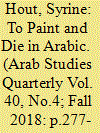|
|
|
Sort Order |
|
|
|
Items / Page
|
|
|
|
|
|
|
| Srl | Item |
| 1 |
ID:
163113


|
|
|
|
|
| Summary/Abstract |
In the post-New Order era, the use of English in Indonesia is noticeably increasing, particularly in otherwise Indonesian popular print texts, a domain where language selection is evident and publicly accessible. The appearance of English in Indonesian popular texts is linguistically known as code-switching, called bahasa gado-gado in the Indonesian context. Although noticeably increasing, English is still unfairly treated by many Indonesians and by the government as a foreign language that carries the “West” ideology. In other words, English not only functions as a linguistic resource but also as a language of Otherness that may carry some Western ideologies for many Indonesians. In fact, the juxtaposition of English and Indonesian in otherwise Indonesian speech acts still receives social censure or is seen as an interference to Indonesian-ness. Using an interpretive textual analysis, I show that code-switching with special reference to English effectively functions to express the overt love expressions and to project one’s socio-cultural hybridity and lingustic proficiency.
|
|
|
|
|
|
|
|
|
|
|
|
|
|
|
|
| 2 |
ID:
163838


|
|
|
|
|
| Summary/Abstract |
I focus on multilingual usages, specifically code-switching between English and Arabic, in Lebanese American Rabih Alameddine's 1998 novel Koolaids: The Art of War. While the novel portrays English as the emancipatory language of coming out and self-acceptance for gay Lebanese men living in the United States between the late 1970s and mid-1990s, Mohammad, a painter, only comes to terms with his impending demise by reverting to Arabic during the final stages of his losing battle with AIDS. Drawing on findings from psycholinguistic, sociolinguistic, translation, and medical/neurological studies, I compare and contrast verbal encounters between Mohammad and various Lebanese and American characters to foreground strategies intended to exclude and/or include certain parties, be they characters or readers. While Arabic words actually employed are few, I argue that implied code-switching and the dynamics of speaker(s), interlocutor(s), setting(s), and context(s) establish links among AIDS, Arabic, art, and acceptance of death; Arabic resurfaces, when Mohammad is on his deathbed, as the language of his childhood and even serves as the bridge toward his “afterlife.” The primary theoretical impacts of my reading are twofold: minimal code-switching does not, as some claim, showcase shallow multilingualism, and a language-minded approach adds a new dimension to the definition of Lebanese (Arab) American literature by focusing on the emotional rather than the national/ethnic facets of the embedded native language.
|
|
|
|
|
|
|
|
|
|
|
|
|
|
|
|
|
|
|
|
|